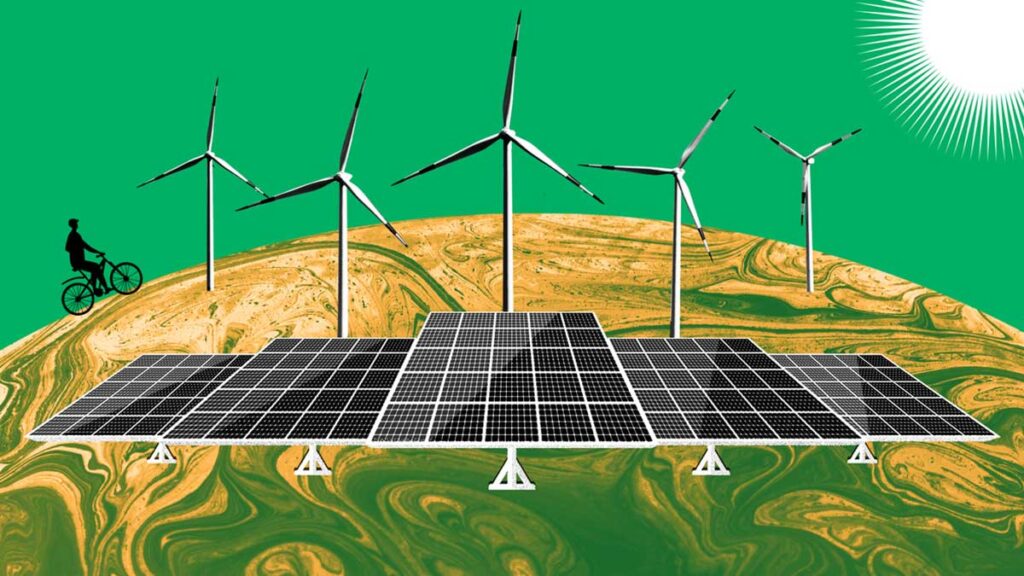“Renewable Energy: Discover the five main types—solar, wind, hydropower, biomass, and geothermal energy—in this comprehensive guide. Learn how each source contributes to a sustainable future.”
Table of Contents
- Introduction
- Solar Energy
- Wind Energy
- Hydropower
- Biomass Energy
- Geothermal Energy
- Frequently Asked Questions (FAQs)
- Conclusion
Introduction Renewable Energy
In an era where sustainable practices are becoming increasingly crucial, renewable energy sources offer a promising solution to our energy needs without the harmful environmental impacts associated with fossil fuels. This blog explores the five main types of renewable energy, highlighting their benefits, applications, and contributions to a greener future.
1. Solar Energy
Solar energy harnesses the power of sunlight through photovoltaic panels or solar thermal systems. It is one of the most abundant and accessible renewable energy sources globally. Solar panels convert sunlight directly into electricity, making it suitable for both residential and commercial use. Advancements in technology have made solar energy more cost-effective and efficient, driving its widespread adoption.
2. Wind Energy
Wind energy utilizes wind turbines to convert kinetic energy from the wind into electricity. Wind farms are often located in areas with consistent and strong wind patterns, such as coastal regions or open plains. As a clean and renewable resource, wind energy plays a significant role in reducing greenhouse gas emissions and meeting energy demands worldwide.
3. Hydropower
Hydropower generates electricity by harnessing the energy of flowing or falling water. It is one of the oldest and most widely used renewable energy sources, with large-scale hydroelectric dams providing a substantial portion of global electricity production. Hydropower is reliable, efficient, and flexible, contributing to grid stability and renewable energy integration.
4. Biomass Energy
Biomass energy is derived from organic materials such as wood, crop residues, and animal waste. Through processes like combustion, gasification, or fermentation, biomass can be converted into heat, electricity, or biofuels. Biomass energy is considered carbon-neutral because the carbon dioxide released during combustion is offset by the carbon dioxide absorbed during the growth of the biomass feedstock.
5. Geothermal Energy
Geothermal energy harnesses heat from beneath the Earth’s surface to generate electricity or provide heating and cooling. This renewable energy source relies on natural processes of heat production within the Earth’s crust. Geothermal power plants can operate continuously, providing stable and baseload electricity compared to intermittent sources like solar and wind.
Frequently Asked Questions (FAQs)
Q1: What are the benefits of renewable energy? Renewable energy sources reduce greenhouse gas emissions, promote energy independence, and stimulate economic growth through job creation in the renewable energy sector.
Q2: How reliable are renewable energy sources compared to fossil fuels? While renewable energy sources can be intermittent (e.g., solar and wind), advancements in energy storage and grid management are improving reliability and integration into existing energy systems.
Q3: Are there any disadvantages to renewable energy? Challenges include intermittency for solar and wind, land use requirements for large-scale projects like hydropower and biomass, and initial high costs of some technologies.
Q4: How can individuals contribute to renewable energy adoption? Individuals can support renewable energy by installing solar panels, choosing renewable energy suppliers, and advocating for policies that promote clean energy initiatives.
Conclusion
The transition to renewable energy is essential for mitigating climate change and ensuring a sustainable future. Each of the five main types of renewable energy—solar, wind, hydropower, biomass, and geothermal—offers unique advantages and applications in our quest for cleaner and more efficient energy solutions. By embracing these technologies and continuing to innovate, we can build a greener and more resilient global energy system.
In conclusion, understanding and promoting renewable energy sources is crucial for a sustainable future. By harnessing the power of solar, wind, hydropower, biomass, and geothermal energy, we can reduce our carbon footprint and pave the way for a cleaner planet. Whether through individual actions or global policies, the shift towards renewables represents a significant step towards environmental stewardship and energy security.
3.5

1 Comment
Pingback: How to Full Screen Undertale on PC?